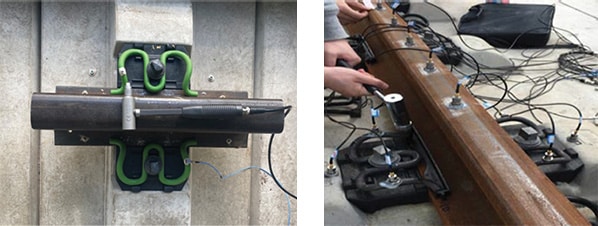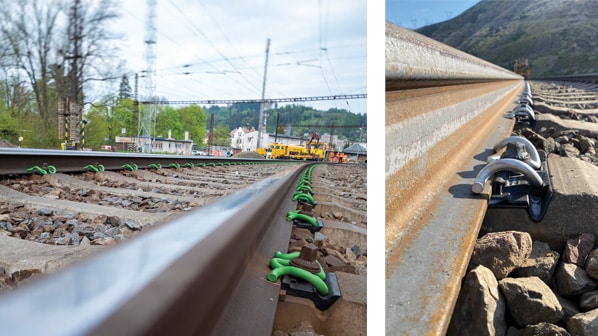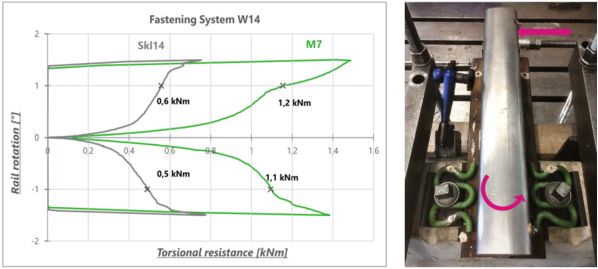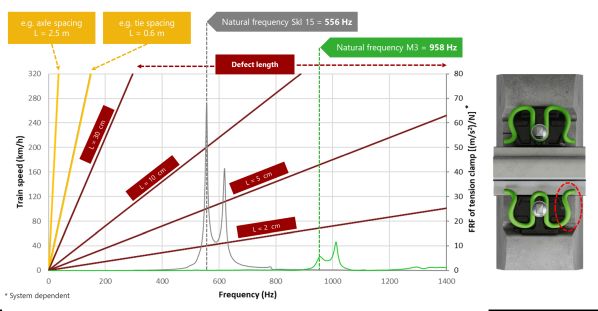ONE of the highlight exhibits for Vossloh at last September’s InnoTrans exhibition was the track equipment supplier’s newly designed rail fasteners.
Featuring outward bent spring arms, the fastener has adopted an entirely new shape resembling an “M.” Vossloh says the new design sets the manufacturer on a “revolutionary new path” and will offer three distinct advantages:
- long-term reliability in the track despite increasing traffic and heavier loads
- a significantly improved carbon footprint over the whole life, and
- reduced complexity in supply chain safety.
Development at Vossloh’s plant in Werdohl, Germany, started in 2016 with the primary objective of achieving a higher natural frequency and/or a reduced resonance/sensitivity of the tension clamps to vibrations caused by passing trains. Investigations into the vibration behaviour of the track under a passing train showed that in certain track conditions, such as unevenness of the track or rail defects, the loads exerted by the train can increase significantly. Flaws in the rail vehicles themselves, such as uneven wheels, can add to the dynamic loads. Especially high additional loads are also experienced from high-frequency vibrations observed on high-speed lines and in urban transport.
The project’s first step was to optimise the proven Skl 15 tension clamp, which has been in service since 1987, as part of the 300-1 fastening system for high-speed lines with operating speeds of up to 380km/h. A study by a partner institute of the impact of a polygonal wheel on the vibration behaviour of the Skl 15 tension clamp found that at a speed of 300km/h, two particularly conspicuous excitation frequencies can be identified at 517Hz and 610Hz. Under certain circumstances, these changed excitation frequencies may result in increased vibrations.
“This indicates that a significant increase in the natural frequency is key to protecting the ruggedness of the tension clamp against external influences in the long term,” says Mr Tobias Gärtner, manager, application engineering/product management, at Vossloh.
For calculating and modelling the natural frequency of the tension clamps, Vossloh used a co-simulation method new to the railway industry that combines the Finite Element Method (FEM) with a Multi-Body Simulation (MBS) (IRJ September 2017). This approach was chosen because in the real world, determining the natural frequency - the vibrations of a component - is difficult and only possible on the basis of amplitudes.
To ensure durability and safety, different vertical deflection behaviours must be taken into account, which may cause problems depending on the structure of the subgrade and the rigidity of the permanent way.
The FEM method mainly provides a modal and load analysis. However, by including additional material parameters in the calculations, statements on elasticity, clamping force, fatigue strength, loads and potential failure are possible. In addition, through the use of elastic bodies and the performance of 4D time-dependent simulations, the FEM model was condensed. This was then used as the starting point for the MBS calculation aimed at determining the natural frequency of the tension clamp and the rail fastening system.
To verify the quality of the calculations, numerous laboratory test series were performed to determine the natural frequency. The impact hammer test method is a proven procedure to identify the relationship between an applied force and the accelerations it induces. For this, an impulse hammer is used and the standard impulse load on the rail head is extracted, while the acceleration is recorded by special accelerometers located on the rail and the tension clamp. These not only record the physical acceleration but also convert it into an electronic signal with an upper frequency limit of more than 10kHz.
The laboratory tests confirmed that the natural frequency of the Skl 15 is indeed in and around the 600Hz range. The design objective therefore was clear: to make the railway infrastructure as a whole more durable and resilient to increasing traffic, and to exclude an overlapping of natural and excitation frequencies in this range, the natural frequency had to be increased significantly.
M3 development
Various approaches were combined and trialled as the traditional W-tension clamp evolved into the M-tension clamp.
The Skl 15 HF, now branded M3, is mainly designed for track experiencing a natural frequency of over 900Hz. It features the new S-shaped contour of the outward bent spring arms (Figure 1). “This ensures a larger area of contact at the rail foot and a reduced contact tension,” explains Mr Winfried Bösterling, global executive vice-president for innovation and R&D at Vossloh and a member of the company’s management board.
Various laboratory measurements and track trials, which were carried out jointly with universities and testing institutes, confirmed that the M3 in the 300 fastening system satisfies all technical requirements (Figure 2). Following approval, it has already been installed on test tracks in Europe and Asia.

The successful approach adopted for the M design has already been extended to other track applications. Indeed, each M tension clamp is compatible with existing rail fastening systems and combines the characteristics of several proven tension clamps.
The M7, for example, is a suitable alternative to the Skl 1, Skl 14 and Skl 21 tension clamps in high-speed and mainline ballasted track as well as in slab track used by metros (Figure 3). For lines with extreme demands, such as very tight curves or heavy-haul traffic with high axleloads, the M9 can replace the Skl 14 R, Skl 30, Skl 40, and Skl 42 tension clamps in the medium term. “This way, our customers will benefit from reduced complexity in the track in the future,“ Gärtner says.

“The comprehensive scientific analyses of frequencies, movements and the exerted forces were carried out in Vossloh’s established innovation and development management process,” Bösterling says. “As well as the natural frequency, aspects such as sustainability, material input and higher fatigue strengths were explored. The latter were achieved by accounting for the three-dimensional loads - longitudinal, lateral and vertical - through a unique geometry.”
The reduction in rail movement exhibited compared with the W systems, partly because the lateral rigidity of the tension clamp is a multiple of that of W systems, not only lowers lifecycle costs by reducing wear and tear and extending the life of the entire fastening system, but also allows the use of more elastic rail fastening systems.
With the M Generation tension clamps, Vossloh says it is taking a definitive step in the fight against global warming by improving the reliability and availability of the rail network. For example, thanks to a higher torsional resistance, the maximum rail temperature can be raised without risking a derailment due to a lateral displacement (Figure 4).

In addition, for the highest fatigue strengths, Vossloh has adopted a micro-steel alloy. In the production of the new tension clamps, the supplier employs a technology that combines low-tension bending and enhanced hardening. This, in conjunction with the compact product design, permits a significant reduction of CO2 emissions over the entire lifecycle.
“Depending on the application and size of the M tension clamp, we are talking about a reduction of CO2 emissions by as much as 40% versus those of comparable W tension clamps,” Bösterling says. “At the same time, the compact design and the lower weight will reduce logistics costs by about 10%.”
The intensive analysis of the interaction between excitation frequency, characteristic natural frequency and resonance vibration has resulted in a definitive optimisation of Vossloh’s own rail fastening systems. Both the track measurements and the feedback from the first service trials are consistently positive and promising, reinforcing the supplier’s confidence in its new product.

